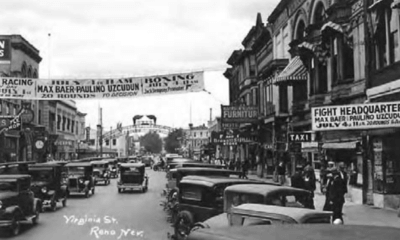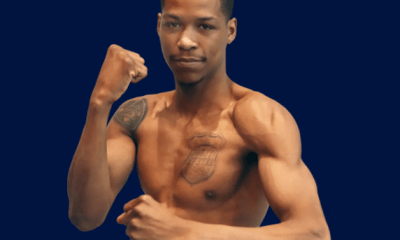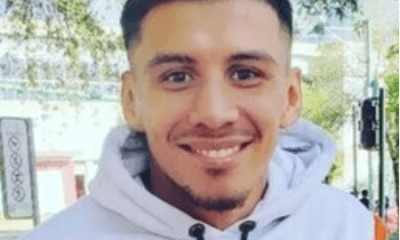Featured Articles
27 Years Ago, Ray Mercer was `Army Strong’ in Rallying Past Tommy Morrison
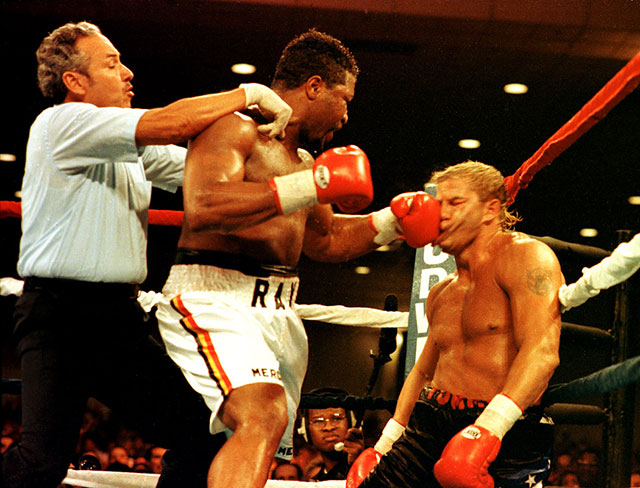
Former heavyweight champion Riddick Bowe lasted just 11 days at the Marine Corps Recruit Depot at Parris Island, S.C., until he was voluntarily granted his release and returned to civilian life. “Big Daddy” might have won two of his three classic battles with Evander Holyfield, but his approach to training camp was seldom military-grade and, besides, gentlemanly trainer Eddie Futch treated him with more patience and fewer cross words than did his expletive-spewing drill instructors.
Before he even took up boxing, future WBO heavyweight titlist Ray Mercer spent nine years in the U.S. Army. He was the recruiting-poster epitome of “Army strong,” toting an M-60 machine gun on his shoulder on 12-mile hikes without complaint, mentally and physically conditioned enough to tough it out on reforger exercises in the snowy woods of Germany, by survival courses in desert heat. In the ring and in the field, Mercer might have been fallible enough to lose, but nothing and no one was ever going to make him quit.
Roommates in the Olympic Village at the 1988 Games in Seoul, South Korea, the less-talented but more positive-thinking Mercer was so put off by what he perceived to be Bowe’s nagging self-doubts about his medal chances that he sought and was granted different quarters so as to not to have his temporary living space infected by what he later termed the younger fighter’s “defeatist attitude.”
Did removing himself from Bowe’s presence help? Well, let the record show that Mercer took the gold medal in the heavyweight division by winning all four of his bouts inside the distance, the last of which was an emphatic, first-round knockout of South Korea’s Baik Hyun-Man. Bowe had to settle for a silver medal in the super heavyweight division, losing in the final on a second-round stoppage. By maybe he shouldn’t be faulted too much for that; his opponent, after all, was some guy named Lennox Lewis, who was representing Canada. Maybe you’ve heard of him.
By any measure, Bowe, now 51, had the more distinguished of the former Olympic teammates’ professional careers, good enough to merit his 2015 induction into the International Boxing Hall of Fame. And, as he demonstrated in his trilogy with Holyfield, he had enough heart and commitment as the occasion warranted to satisfy even the saltiest Marine DI. It’s just that Bowe never found himself in as many pugilistic firefights as did Mercer, now 57, who had to fall back on his Army training whenever the going inside the ropes required he dig deep inside himself to find whatever was required to keep going and, ultimately, win. He has yet to be inducted into the IBHOF, despite having had his last pro bout in 2008, which would have made him eligible for consideration in 2013. Since his name has never even appeared on the ballot, it’s very possible he will never get a call to the hall.
It was the good-soldier Mercer who achieved perhaps his most memorable victory as a pro on Oct. 18, 1991, when the WBO heavyweight champ overcame three-plus rounds of having his butt kicked by young phenom Tommy Morrison to score a fifth-round TKO in Atlantic City’s Boardwalk Hall. The final barrage, which came after an elapsed time of 28 seconds, saw Mercer pummel “The Duke” into unconsciousness along the ropes before referee Tony Perez could jump in.
“I’m kind of glad it went like it did,” Mercer said afterward. “You like to take your man out convincingly, just so people will know he was really out.”
For those who were not in the arena or did not see the entire USA Network telecast, just the brutal knockout sequence that made all the late-news sports segments (and it was most definitely a KO; the only reason it went into the books as a TKO is because Perez dispensed with the formality of a count), it must have appeared that Mercer won in a rout. But for much of what had transpired earlier, quite the opposite was true. Morrison, who went in with a 28-0 record that included 24 KOs, 15 of which were one-round quickies, came out from the opening bell as if he imagined Mercer would also fall victim to his early onslaught. Sylvester Stallone’s co-star (as ungrateful protégé Tommy Gunn) in 1992’s Rocky V landed flush with an assortment of loaded-up punches, most notably his signature left hook but also a ripping right uppercut that would have taken off the head of most opponents. But Mercer was not like anyone Morrison had ever fought to that point as a pro, as he would eventually demonstrate.
The two big hitters – Mercer went in 17-0, with 13 KOs – actually had squared off once before, at the 1988 U.S. Olympic Boxing Trials. The older, more physically mature Mercer won on points, leaving Morrison with a taste for revenge he figured he would satisfy if and when they ever crossed paths again.
“I took a very long walk back to my locker room and looked at myself in the mirror,” Morrison said in the lead-up to the rematch of sorts in Atlantic City. “What I saw looking back at me was a very disappointed 19-year-old with a big decision to make.
“By pursuing my Olympic dream, I passed up several football scholarships and the education that in no way could be paid for by my family. (A linebacker and tight end, he had received an offer from Emporia State in Kansas.) But I knew I had the determination and desire that has driven me forward to the day I become a world champion. Now, the opportunity I’ve longed for is here. I have a chance to legitimize myself as one of the top heavyweights in the world today. And one thing is certain: it’s not 1988 anymore.
“Look, I know Ray’s got one of the best chins in boxing, and certainly he’s got the biggest heart. People like that, it’s not a matter of knocking them down. You have to break their will, make them want to quit. Nobody’s ever done that to Ray before, but I’m going to do it.”
Mercer, who went off a slight 6-5 underdog, listened to Morrison’s tale of festering resentment and shrugged. So what if the kid said he was determined and had desire. He’d never been in the Army, or the Marines for that matter. Pride in your branch of service is important to veterans, and it had rankled Mercer, the Olympic gold medalist, that a story in USA Today had referred to him as an “ex-Marine.”
“I’m not going back to the locker room and look at myself in the mirror,” the seemingly implacable Mercer said in comparing his state of mind and readiness to that of Morrison. “I look in the mirror before something bad happens. That way, I prevent it from happening. I wish Tommy all the luck in the world, but it’s not going to happen for him. He’s going to be right back in the locker room, looking at himself in the mirror again.”
Did Mercer, so capable of soaking up punishment and shaking it off as if punches were raindrops, intentionally expose himself to Morrison’s penchant for going hard and fast with the idea that the popular and possibly overconfident kid, who had never before gone more than six rounds, would burn himself out in a scheduled 12-round bout? Possibly, but not likely; in Mercer’s two previous bouts he had claimed the minor NABF title on a wide 12-round decision over Bert Cooper despite finishing with a grotesquely swollen jaw, and then won the WBO title on a bolt-of-lightning, ninth-round knockout of Italy’s Francesco Damiani, who was so far ahead on points as to be almost uncatchable had the fight gone to the scorecards.
Morrison easily won the first three rounds and was well on his way to winning the fourth when he seemed to tire in the last minute of that round, opening the door for a revived Mercer to launch a counterattack that foreshadowed the brutal ending. As the final seconds of the fourth ticked off, Akbar Muhammad, a Mercer adviser who was seated in the press section, leaped up and excitedly yelled, “Morrison is finished! He’s punched himself out!”
It was a spot-on assessment. Gasping as he came out for round five, Morrison quickly found himself with his back to the ropes, slickly maneuvered there by a spin move from Mercer, who unleashed a rapid-fire, 16-punch volley.
There would be moments later on in his career that Mercer would not be quite so proud of, most notably the $100,000 bribe he allegedly offered Jesse Ferguson during clinches of their Feb. 6, 1993, bout at Madison Square Garden to intentionally lose. The underdog Ferguson declined repeated enticements to go into the tank (apparently verified by enhanced HBO audiotapes) in a fight which the underdog was in the process of winning, and did. The upset loss put the snafu on a proposed shot for Mercer at his onetime Olympic teammate, WBA/IBF champ Bowe, which instead went to Ferguson. This time, however, Mercer – who would have been paid $2.5 million for the Bowe fight — had no one to blame but himself for the missed opportunity; he came in at a then-career-high 238 pounds, or 13 more than weighed for his fight with Morrison 15½ months earlier. Although charges brought against Mercer were eventually dropped (he faced up to seven years in prison had the case gone forward and he was convicted), his once-sterling reputation took a hit from which it might never have fully recovered.
But Mercer was still “Merciless” Ray the night he again played the familiar role of unconquerable soldier against Morrison, doing unto Morrison for real what Sly Stallone had done to the Tommy Gunn character in the closing scenes of Rocky V. To some, Mercer’s escape from the brink was a surprise; to one veteran observer it was anything but.
“I love Mercer’s chances,” Angelo Dundee, the legendary trainer of Muhammad Ali and Sugar Ray Leonard who had no ties to either fighter, had surmised beforehand. “To me, he’s a devastating inside puncher. I noticed that in the amateurs. His footwork is not that fluid, but when he gets inside, he can really percolate. Outside, he looks ungainly. But inside, it’s goodbye, Jack. I honestly believe he’s going to do a number on Morrison.”
Mercer appreciated the positive remarks from Dundee, but he did take exception to one thing. “Angelo Dundee is one of the greatest trainers around,” Mercer said. “It makes me feel good that he feels that way about me. That’s the way I feel about myself, except that I don’t think I’m that ungainly.”
Check out more boxing news on video at The Boxing Channel
-

 Featured Articles3 weeks ago
Featured Articles3 weeks agoAvila Perspective, Chap. 330: Matchroom in New York plus the Latest on Canelo-Crawford
-

 Featured Articles2 weeks ago
Featured Articles2 weeks agoVito Mielnicki Jr Whitewashes Kamil Gardzielik Before the Home Folks in Newark
-

 Featured Articles4 weeks ago
Featured Articles4 weeks agoOpetaia and Nakatani Crush Overmatched Foes, Capping Off a Wild Boxing Weekend
-

 Featured Articles3 weeks ago
Featured Articles3 weeks agoCatching Up with Clay Moyle Who Talks About His Massive Collection of Boxing Books
-

 Featured Articles4 weeks ago
Featured Articles4 weeks agoFabio Wardley Comes from Behind to KO Justis Huni
-

 Featured Articles2 weeks ago
Featured Articles2 weeks agoMore Medals for Hawaii’s Patricio Family at the USA Boxing Summer Festival
-
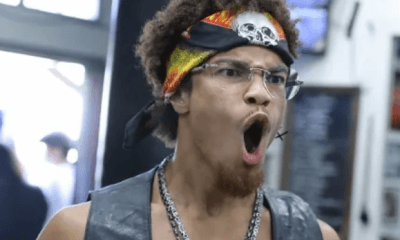
 Featured Articles3 weeks ago
Featured Articles3 weeks agoThe Shafting of Blair “The Flair” Cobbs, a Familiar Thread in the Cruelest Sport
-

 Featured Articles3 weeks ago
Featured Articles3 weeks agoRichardson Hitchins Batters and Stops George Kambosos at Madison Square Garden





